Nissan Juke Service and Repair Manual : Basic inspection
Work Procedure
1.INSPECTION START
1. Check service records for any recent repairs that may indicate a related malfunction, or a current need for scheduled maintenance.
2. Open engine hood and check the following:
- Harness connectors for improper connections
- Wiring harness for improper connections, pinches and cut
- Vacuum hoses for splits, kinks and improper connections
- Hoses and ducts for leaks
- Air cleaner clogging
- Gasket
3. Confirm that electrical or mechanical loads are not applied.
- Headlamp switch is OFF.
- Air conditioner switch is OFF.
- Rear window defogger switch is OFF.
- Steering wheel is in the straight-ahead position, etc.
4. Start engine and warm it up until engine coolant temperature indicator points to the middle of gauge.
Ensure engine stays below 1,000 rpm.
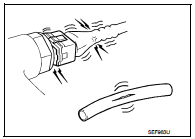
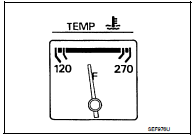
5. Run engine at about 2,000 rpm for about 2 minutes under no load.
6. Make sure that no DTC is displayed with CONSULT-III or GST.
Is any DTC detected? YES >> GO TO 2.
NO >> GO TO 3.
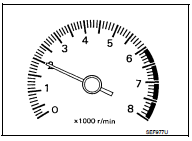
2.REPAIR OR REPLACE
Repair or replace components as necessary according to corresponding Diagnostic Procedure.
>> GO TO 3
3.CHECK TARGET IDLE SPEED
1. Run engine at about 2,000 rpm for about 2 minutes under no load.
2. Rev engine (2,000 to 3,000 rpm) two or three times under no load, then run engine at idle speed for about 1 minute.
3. Check idle speed.
For procedure, refer to EC-801, "Inspection".
For specification, refer to EC-807, "Idle Speed".
Is the inspection result normal? YES >> GO TO 10.
NO >> GO TO 4.
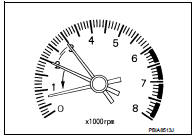
4.PERFORM ACCELERATOR PEDAL RELEASED POSITION LEARNING
1. Stop engine.
2. Perform EC-542, "Work Procedure".
>> GO TO 5.
5.PERFORM THROTTLE VALVE CLOSED POSITION LEARNING
Perform EC-543, "Work Procedure".
>> GO TO 6.
6.PERFORM IDLE AIR VOLUME LEARNING
Perform EC-544, "Work Procedure".
Is Idle Air Volume Learning carried out successfully? YES >> GO TO 7.
NO >> Follow the instruction of IDLE AIR VOLUME LEARNING. Then GO TO 4.
7.CHECK TARGET IDLE SPEED AGAIN
1. Start engine and warm it up to normal operating temperature.
2. Check idle speed.
For procedure, refer to EC-801, "Inspection".
For specification, refer to EC-807, "Idle Speed".
Is the inspection result normal? YES >> GO TO 10.
NO >> GO TO 8.
8.DETECT MALFUNCTIONING PART
Check the Following.
• Check camshaft position sensor (PHASE) and circuit. Refer to EC-660, "DTC Logic".
• Check crankshaft position sensor (POS) and circuit. Refer to EC-656, "DTC Logic".
Is the inspection result normal? YES >> GO TO 9.
NO >> Repair or replace. Then GO TO 4.
9.CHECK ECM FUNCTION
1. Substitute another known-good ECM to check ECM function. (ECM may be the
cause of an incident, but
this is a rare case.)
2. Perform initialization and registration of all NATS ignition key IDs. Refer
to SEC-50, "BCM : Special Repair
Requirement" (With intelligent key system), SEC-190, "BCM : Work Procedure"
(Without intelligent key
system).
>> GO TO 4.
10.CHECK IGNITION TIMING
1. Run engine at idle.
2. Check ignition timing with a timing light.
For procedure, refer to EC-802, "Inspection".
For specification, refer to EC-807, "Ignition Timing".
- Timing indicator (1) Is the inspection result normal? YES >> GO TO 19.
NO >> GO TO 11.
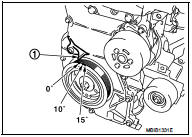
11.PERFORM ACCELERATOR PEDAL RELEASED POSITION LEARNING
1. Stop engine.
2. Perform EC-542, "Work Procedure".
>> GO TO 12.
12.PERFORM THROTTLE VALVE CLOSED POSITION LEARNING
Perform EC-543, "Work Procedure".
>> GO TO 13.
13.PERFORM IDLE AIR VOLUME LEARNING
Perform EC-544, "Work Procedure".
Is idle air volume learning carried out successfully? YES >> GO TO 14.
NO >> Follow the instruction of IDLE AIR VOLUME LEARNING. Then GO TO 4.
14.CHECK TARGET IDLE SPEED AGAIN
1. Start engine and warm it up to normal operating temperature.
2. Check idle speed.
For procedure, refer to EC-801, "Inspection".
For specification, refer to EC-807, "Idle Speed".
Is the inspection result normal? YES >> GO TO 15.
NO >> GO TO 17.
15.CHECK IGNITION TIMING AGAIN
1. Run engine at idle.
2. Check ignition timing with a timing light.
For procedure, refer to EC-802, "Inspection".
For specification, refer to EC-807, "Ignition Timing".
- Timing indicator (1)
Is the inspection result normal? YES >> GO TO 19.
NO >> GO TO 16.
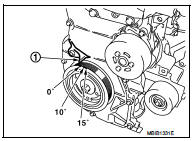
16.CHECK TIMING CHAIN INSTALLATION
Check timing chain installation. Refer to EM-181, "Exploded View".
Is the inspection result normal? YES >> GO TO 17.
NO >> Repair the timing chain installation. Then GO TO 4.
17.DETECT MALFUNCTIONING PART
Check the following.
• Check camshaft position sensor (PHASE) and circuit. Refer to EC-660, "DTC Logic".
• Check crankshaft position sensor (POS) and circuit. Refer to EC-656, "DTC Logic".
Is the inspection result normal? YES >> GO TO 18.
NO >> Repair or replace. Then GO TO 4.
18.CHECK ECM FUNCTION
1. Substitute another known-good ECM to check ECM function. (ECM may be the
cause of an incident, but
this is a rare case.)
2. Perform initialization of NATS system and registration of all NATS ignition
key IDs. Refer to SEC-50,
"BCM : Special Repair Requirement" (With intelligent key system), SEC-190, "BCM
: Work Procedure"
(Without intelligent key system).
>> GO TO 4.
19.INSPECTION END
If ECM is replaced during this BASIC INSPECTION procedure, perform EC-541, "Work Procedure".
>> INSPECTION END
 Mixture ratio self-learning value clear
Mixture ratio self-learning value clear
Description
This describes how to erase the mixture ratio self-learning value. For the
actual procedure, follow the instructions
in “Diagnosis Procedure”.
Work Procedure
1.START
With CONSULT-II ...
 Fuel pressure check
Fuel pressure check
Work Procedure
FUEL PRESSURE RELEASE
1.FUEL PRESSURE RELEASE
With CONSULT-III
1. Turn ignition switch ON.
2. Perform “FUEL PRESSURE RELEASE” in “WORK SUPPORT” mode with CONSULT-III.
3. Start eng ...
Other materials:
Rear combination lamp
Exploded View
REMOVAL
1. Grommet
2. Grommet
3. Rear combination lamp
: Clip
: N·m (kg-m, in-lb)
DISASSEMBLY
1. Rear combination lamp housing assembly
2. Back-up lamp bulb
3. Harness connector
4. Rear turn signall lamp bulb
5. Stop/tail lamp bulb
Removal and Installation
CAUTIO ...
B1113, B1114 satellite sensor RH
DTC Logic
DTC DETECTION LOGIC
1.CHECK SELF-DIAG RESULT
With CONSULT-III
1. Turn ignition switch ON.
2. Perform “Self Diagnostic Result” mode of “AIR BAG” using CONSULT-III.
Without CONSULT-III
1. Turn ignition switch ON.
2. Check the air bag warning lamp status. Refer to SRC-12, "On ...
Back door trim
Exploded View
1. Back door side finisher RH
2. Rear parcel shelf finisher
3. Back door side finisher LH
4. Back door lower finisher
5. Emergency lid
6. Back door pull handle
: Clip
: Pawl
Back door pull handle : Removal and Installation
REMOVAL
CAUTION:
• When removing, always use ...
